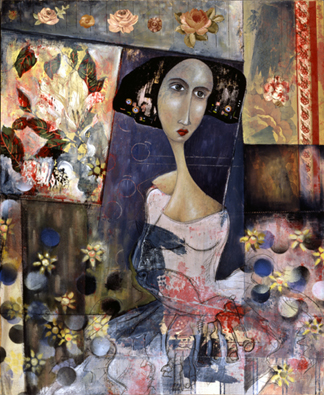Nicolas Harper, His Rogue Buddha, and the Eternal Feminine
Valerie Valentine visits the Rogue Buddha Gallery's new location in Northeast Minneapolis, finding the change good.

October 25 is Nicholas Harper’s birthday, and also that of Picasso. Harper’s new space at 357 13th Ave. NE, the relocated Rogue Buddha gallery, opened with a show of its founder’s work: cubist-inspired portraits, and a vision for the future.
Harper moved to the centralized Northeast location after five years on East Hennepin. The art traffic will be improved here: Rogue Buddha shares the avenue with 212 Pottery, Frank Stone Gallery, and two other recent immigrants, Minnesota Center for Photography and Artrujillo Gallery, both moved in from South Minneapolis.
The space itself is reminiscent of the old spot, only bigger: a long room facing the street, windows around the door, with a few new embellishments. Harper’s studio used to be downstairs; here it’s right off the main space, with a better layout. The new underlit bar and table add some class and elegance.
Harper’s added an “Accent Gallery,” where he keeps smaller-ticket items by local artists for sale. At the old spot, the basement served much the same purpose, but here it is more accessible. Other galleries, like SooVAC and Steven’s Square Center for the Arts, have attempted small sales areas. Artamotive is an artisan store that also serves as a gallery; Gallery 360 does it, too. Other galleries do framing. Having back-up income is a wise move for galleries, in case a show bombs and nothing sells, or if patrons are just low-income folk who can’t cough up three grand for an original.
Harper’s own show was lovely. Ranging from new brides to wise matrons, his pantheon of women exudes mystery, their brooding eyes gazing out from the walls. Pablo Picasso liked to portray women, too – it was his steady obsession. To portray the perplexity of femininity as a man is an ambitious objective that Harper performs with respect and devotion.
One figure repeats through this series. I’ll call this repeated subject “Rose.” Rose has rich red backgrounds in some paintings, pale pink in others. The artist has chosen his female focus: the reedlike form of a woman’s throat. The girl’s got a neck like a toothpick, on which she balances her olive head steadily. Her brainstem connects the spine to the heart to the hips, a nervous system’s superhighway. Rose’s placid, unyielding stare beseeches conversation. Brazen but not bullying, this melancholy maiden supplicates the viewer, entreating a private audience to impart her forbidden knowledge.
Many works are mixed media, with wallpaper pieces inserted into the paint. The effect of collage is twofold – it draws attention to surface, while staggering frames of reference. The paper appears vintage, with a twist of kitsch; the artists invokes the past in the present.
“Dream Series” contrasts starkly with the colorful forms of the portraits. In these umber and gold zones, a lone female contorts her nude body. The lady’s jagged edges are like lightning. Her body is electric, and positively vibrates with life force.
This girl stands faceless, but her twisted body is distilled girliness, the shadow of woman’s commodified form. Titles like “(The Weight of 1 AM)” and “(I Thought I was Someone Else)” acknowledge the dark precinct of nighttime reveries, an immanent region of the mind during Midwest’s midwinter. A straight sepia palette keeps it dreamlike (not all of us dream in color.)
Wild shape makes the figures supernatural. They’re not surreal; Harper calls his mode “magical realism,” alluding to South American writers such as Gabriel Garcia Marquez. Some of the characters in Harper’s paintings spring from these fictions.
Most artists have many inspirations. Harper collects ideas by inviting other artists through his doors. The Rogue Buddha gallery has hosted theatrical performances, poetry readings, dance groups, and bands over the years. Such a cast of local characters would undeniably stir the cauldron of creativity.
The gallery currently shows the art of Ryan Kelly, “Slowly Learning that Life is O.K.” The shop is situated to become a hotspot–among these newcomer galleries and patrons, it will undoubtedly charge the Northeast scene.